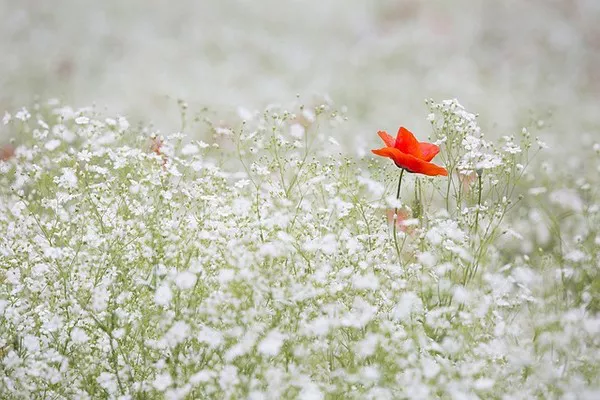Wildflowers, with their vibrant colors and delicate beauty, captivate our senses and add a touch of natural splendor to landscapes. Whether they adorn meadows, fields, or roadside verges, their presence brings joy and biodiversity to the environment. However, the journey from seed to bloom is a nuanced process influenced by various factors such as species, climate, soil conditions, and human intervention. In this comprehensive guide, we delve into the intricacies of wildflower growth timelines, shedding light on the stages and durations involved in their remarkable transformation.
The Germination Phase: Setting Roots
At the heart of every wildflower’s life cycle lies the germination phase, where the journey begins from a tiny seed buried beneath the soil. Germination marks the awakening of life within the seed, triggered by a combination of moisture, warmth, and oxygen. The time it takes for germination to occur varies significantly among different wildflower species.
For some, such as the California poppy (Eschscholzia californica), germination can occur within a mere 7 to 15 days under optimal conditions, making them among the fastest to sprout. On the other hand, species like the bluebonnet (Lupinus texensis) may take longer, requiring approximately 20 to 30 days to emerge from their dormant state.
Establishment and Growth: Nurturing Nature’s Canvas
Once germination occurs, the seedling embarks on a journey of growth and establishment. During this phase, the delicate roots delve deeper into the soil, anchoring the plant securely and absorbing essential nutrients and water. Meanwhile, the shoot emerges from the earth, reaching towards the sun in a quest for light energy through photosynthesis.
The duration of this growth phase varies widely depending on factors such as species, environmental conditions, and soil quality. In favorable circumstances, some wildflowers can achieve significant growth within a matter of weeks, while others may take several months to establish themselves fully. For instance, the black-eyed Susan (Rudbeckia hirta) typically requires 8 to 10 weeks from germination to the flowering stage, while the iconic sunflower (Helianthus annuus) may take up to 3 months before displaying its radiant blooms.
Environmental Influences: Nature’s Hand in the Growth Process
While wildflowers possess innate resilience and adaptability, their growth and development are profoundly influenced by environmental factors. Climate, soil composition, moisture levels, and sunlight exposure all play pivotal roles in shaping the trajectory of their growth.
In regions with temperate climates and ample rainfall, wildflowers often thrive, experiencing accelerated growth and prolific blooming. Conversely, in arid environments or areas prone to drought, their growth may be stunted, and flowering delayed as they struggle to obtain sufficient water and nutrients from the soil.
Soil quality also emerges as a critical determinant of wildflower growth. Rich, well-drained soils provide an ideal foundation for robust root development and nutrient uptake, fostering healthy plant growth and vibrant blooms. Conversely, compacted or nutrient-poor soils can impede growth, resulting in stunted plants with diminished flowering potential.
Human Intervention: Cultivating Beauty
In addition to natural influences, human intervention plays a significant role in shaping the growth trajectory of wildflowers. Gardeners, conservationists, and land managers employ various techniques to promote wildflower growth and enhance biodiversity in cultivated landscapes.
Seed stratification, a process that mimics natural dormancy-breaking conditions, is commonly employed to improve germination rates and accelerate growth. By subjecting seeds to periods of cold and moisture, dormancy barriers are overcome, paving the way for more uniform and robust germination.
Selective breeding and hybridization represent another avenue through which humans influence wildflower growth. Through careful selection of desirable traits such as color, size, and disease resistance, breeders develop cultivars that exhibit enhanced ornamental qualities and adaptability to specific environmental conditions.
Longevity and Persistence: A Testament to Nature’s Resilience
While the duration of a wildflower’s growth cycle may vary, their enduring presence in the landscape serves as a testament to nature’s resilience and adaptability. Many wildflower species have evolved mechanisms to ensure their survival in challenging environments, from developing deep root systems to storing energy reserves for periods of dormancy.
Perennial wildflowers, in particular, exhibit remarkable longevity, often persisting for multiple growing seasons and resuming growth with each subsequent year. Through a combination of vegetative reproduction and seed dispersal, these enduring plants contribute to the ongoing vitality and biodiversity of their ecosystems.
Conclusion
In the intricate tapestry of nature, the growth of wildflowers represents a harmonious convergence of biological processes, environmental influences, and human stewardship. From the humble seedling emerging from the soil to the resplendent bloom adorning meadows and gardens, each stage of the wildflower’s journey offers insight into the beauty and resilience of the natural world.
By understanding the factors that shape their growth timeline, we gain a deeper appreciation for the fleeting beauty of wildflowers and the enduring legacy they leave upon the landscape. As stewards of the environment, let us embrace our role in nurturing and preserving these botanical treasures, ensuring that future generations may continue to marvel at nature’s timeless cycle of growth and renewal.


